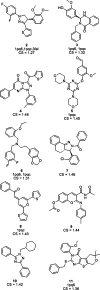Discovery of new liver X receptor agonists by pharmacophore modeling and shape-based virtual screening
- PMID: 24502802
- PMCID: PMC3934620
- DOI: 10.1021/ci400682b
Discovery of new liver X receptor agonists by pharmacophore modeling and shape-based virtual screening
Abstract
Agonists of liver X receptors (LXR) α and β are important regulators of cholesterol metabolism, but agonism of the LXRα subtype appears to cause hepatic lipogenesis, suggesting LXRβ-selective activators are attractive new lipid lowering drugs. In this work, pharmacophore modeling and shape-based virtual screening were combined to predict new LXRβ-selective ligands. Out of the 10 predicted compounds, three displayed significant LXR activity. Two activated both LXR subtypes. The third compound activated LXRβ 1.8-fold over LXRα.
Figures




Similar articles
-
Three-dimensional pharmacophore modeling of liver-X receptor agonists.J Chem Inf Model. 2011 Sep 26;51(9):2147-55. doi: 10.1021/ci100511v. Epub 2011 Mar 24. J Chem Inf Model. 2011. PMID: 21434646
-
Predicting selective liver X receptor β agonists using multiple machine learning methods.Mol Biosyst. 2015 May;11(5):1241-50. doi: 10.1039/c4mb00718b. Mol Biosyst. 2015. PMID: 25734698
-
LXR{beta} is the dominant LXR subtype in skeletal muscle regulating lipogenesis and cholesterol efflux.Am J Physiol Endocrinol Metab. 2010 Mar;298(3):E602-13. doi: 10.1152/ajpendo.00553.2009. Epub 2009 Dec 8. Am J Physiol Endocrinol Metab. 2010. PMID: 19996385
-
Liver X receptors as potential therapeutic targets in atherosclerosis.Clin Invest Med. 2009 Oct 1;32(5):E383-94. doi: 10.25011/cim.v32i5.6927. Clin Invest Med. 2009. PMID: 19796580 Review.
-
Recent progress in liver X receptor-selective modulators.Curr Opin Drug Discov Devel. 2010 Jul;13(4):403-13. Curr Opin Drug Discov Devel. 2010. PMID: 20597026 Review.
Cited by
-
Structure-based discovery of potentially active semiochemicals for Cydia pomonella (L.).Sci Rep. 2016 Oct 6;6:34600. doi: 10.1038/srep34600. Sci Rep. 2016. PMID: 27708370 Free PMC article.
-
Shape similarity guided pose prediction: lessons from D3R Grand Challenge 3.J Comput Aided Mol Des. 2019 Jan;33(1):47-59. doi: 10.1007/s10822-018-0142-x. Epub 2018 Aug 6. J Comput Aided Mol Des. 2019. PMID: 30084081
-
Hierarchical virtual screening approaches in small molecule drug discovery.Methods. 2015 Jan;71:26-37. doi: 10.1016/j.ymeth.2014.07.007. Epub 2014 Jul 27. Methods. 2015. PMID: 25072167 Free PMC article. Review.
-
A de novo substructure generation algorithm for identifying the privileged chemical fragments of liver X receptorβ agonists.Sci Rep. 2017 Sep 11;7(1):11121. doi: 10.1038/s41598-017-08848-4. Sci Rep. 2017. PMID: 28894088 Free PMC article.
-
Nuclear Receptor NR1H3 in Familial Multiple Sclerosis.Neuron. 2016 Jun 1;90(5):948-54. doi: 10.1016/j.neuron.2016.04.039. Neuron. 2016. PMID: 27253448 Free PMC article.
References
-
- Ibanez B.; Vilahur G.; Cimmino G.; Speidl W. S.; Pinero A.; Choi B. G.; Zafar M. U.; Santos-Gallego C. G.; Krause B.; Badimon L.; Fuster V.; Badimon J. J. Rapid change in plaque size, composition, and molecular footprint after recombinant apolipoprotein A-I Milano (ETC-216) administration: Magnetic resonance imaging study in an experimental model of atherosclerosis. J. Am. Coll. Cardiol. 2008, 51, 1104–1109. - PubMed
-
- Nissen S. E.; Tsunoda T.; Tuzcu E. M.; Schoenhagen P.; Cooper C. J.; Yasin M.; Eaton G. M.; Lauer M. A.; Sheldon W. S.; Grines C. L.; Halpern S.; Crowe T.; Blankenship J. C.; Kerensky R. Effect of recombinant ApoA-I Milano on coronary atherosclerosis in patients with acute coronary syndromes: A randomized controlled trial. JAMA, J. Am. Med. Assoc. 2003, 290, 2292–2300. - PubMed
-
- Tardif J.-C.; Grégoire J.; L’Allier P. L.; Ibrahim R.; Lespérance J.; Heinonen T. M.; Kouz S.; Berry C.; Basser R.; Lavoie M.-A.; Guertin M.-C.; Rodés-Cabau J. Effects of reconstituted high-density lipoprotein infusions on coronary atherosclerosis: A randomized controlled trial. JAMA, J. Am. Med. Assoc. 2007, 297, 1675–1682. - PubMed
-
- Cuchel M.; Rader D. J. Macrophage reverse cholesterol transport: Key to the regression of atherosclerosis?. Circulation 2006, 113, 2548–2555. - PubMed
-
- Tall A. R. Cholesterol efflux pathways and other potential mechanisms involved in the athero-protective effect of high density lipoproteins. J. Intern. Med. 2008, 263, 256–273. - PubMed
Publication types
MeSH terms
Substances
LinkOut - more resources
Full Text Sources
Other Literature Sources

